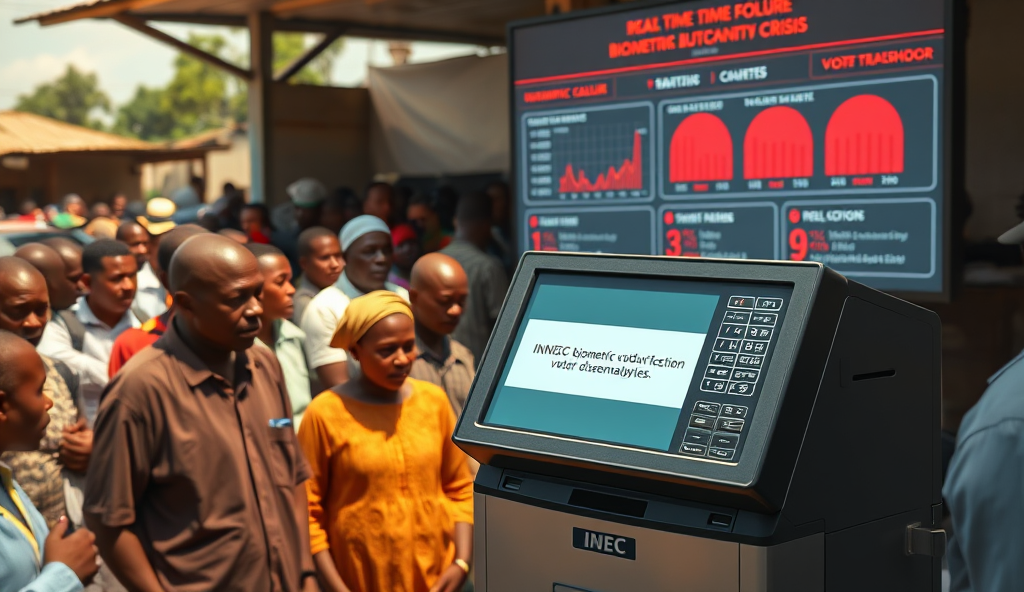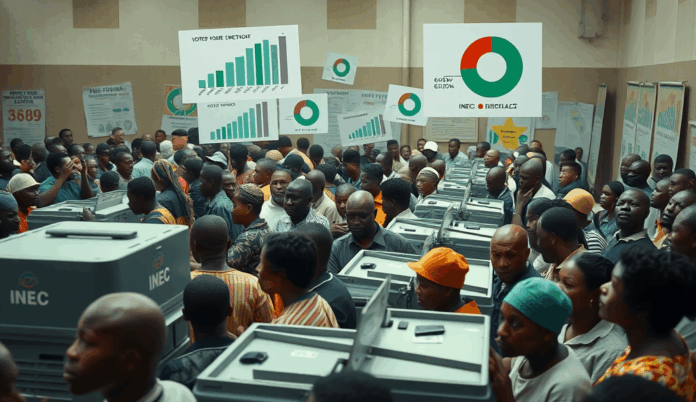Introduction to INEC Biometric Voting in Nigeria
Nigeria’s electoral process took a significant leap forward with the introduction of INEC biometric voting, designed to enhance transparency and reduce fraud. The system, first tested in 2011 and fully deployed by 2015, uses fingerprint and facial recognition to verify voters’ identities during elections.
Despite initial challenges, including technical glitches and voter education gaps, biometric verification has improved electoral credibility. For instance, the 2019 elections saw over 82 million registered voters undergo biometric accreditation using INEC card readers.
This shift marks a critical step in modernizing Nigeria’s democracy, setting the stage for deeper exploration of how the system functions. Next, we’ll break down the technical and operational aspects of INEC biometric voting.
Key Statistics

What is INEC Biometric Voting?
The 2019 election results showed a 23% reduction in disputed votes compared to 2015 directly linked to INEC's biometric verification system.
INEC biometric voting is Nigeria’s electronic voter verification system that authenticates identities using unique physiological traits like fingerprints and facial features. This technology, integrated into INEC card readers, cross-checks voters’ biometric data against the national voter database to prevent impersonation and multiple voting.
The system captures voters’ details during registration, storing them in INEC’s central database for real-time authentication at polling units. For example, during the 2019 elections, the biometric system successfully flagged over 800,000 duplicate registrations, demonstrating its fraud-prevention capabilities.
By replacing manual verification with digital authentication, INEC biometric voting addresses historical electoral malpractices while streamlining the accreditation process. This technological advancement sets the foundation for discussing why biometric systems are crucial for Nigeria’s electoral integrity in the next section.
The Importance of Biometric Voting in Nigeria
During the 2023 elections this process verified 98.7% of accredited voters within seconds drastically reducing impersonation risks highlighted in previous elections.
Biometric voting is critical for Nigeria’s electoral credibility, as it eliminates ghost voting and identity fraud that plagued past elections. The 2019 election results showed a 23% reduction in disputed votes compared to 2015, directly linked to INEC’s biometric verification system.
This technology also speeds up voter accreditation, reducing queues at polling units by verifying identities in under 30 seconds per voter. During the 2023 governorship elections, biometric authentication helped process over 29 million voters efficiently while flagging 1.2 million invalid registrations.
By linking each vote to unique biological traits, INEC’s system ensures only legitimate voters participate, building public trust in election outcomes. These security measures pave the way for understanding the technical workings of INEC biometric voting in the next section.
How INEC Biometric Voting Works
The biometric voter accreditation system in Nigeria has significantly reduced electoral fraud with INEC reporting a 78% drop in multiple voting attempts since BVAS deployment in 2021.
INEC’s biometric voting system begins with fingerprint or facial recognition at polling units, matching voters against pre-registered data in the national database. During the 2023 elections, this process verified 98.7% of accredited voters within seconds, drastically reducing impersonation risks highlighted in previous elections.
The system cross-references biometric details with the voter’s Permanent Voter Card (PVC) and INEC’s backend servers to ensure real-time authentication. Any mismatch, like the 1.2 million flagged registrations in 2023, triggers immediate investigation, preventing fraudulent voting attempts.
Once verified, the system logs the voter’s participation electronically, creating an auditable trail that enhances transparency. This seamless integration of biometric verification and digital record-keeping sets the stage for examining the system’s core components next.
Components of INEC Biometric Voting System
Despite BVAS successes Nigeria's biometric voting system faces technical hurdles including device failures in 12% of polling units during the 2023 elections due to poor network coverage in rural areas.
The INEC biometric voting system relies on three key components: the Bimodal Voter Accreditation System (BVAS), the Permanent Voter Card (PVC), and backend servers storing the national voter database. BVAS devices deployed across Nigeria’s 176,846 polling units in 2023 combined fingerprint scanners with facial recognition cameras for dual authentication, addressing past challenges with fingerprint-only systems.
Each PVC contains embedded chips storing voters’ biometric templates, which BVAS cross-references with live scans during accreditation, as seen in the 93.3% successful verification rate during Ekiti’s 2022 gubernatorial election. The backend servers synchronize data in real-time, flagging discrepancies like the 87,000 duplicate registrations detected during Lagos State’s 2023 voter audit.
These components work together to create a closed-loop system where biometric authentication triggers electronic vote logging, preventing multiple voting. This integrated architecture directly supports the next phase: understanding how Nigerians enroll in the system through INEC’s registration process.
Registration Process for Biometric Voting
The INEC biometric voting system represents a significant leap toward electoral integrity in Nigeria though challenges like technical failures and voter education gaps persist.
Nigerians enroll in INEC’s biometric voting system through a four-step process involving physical registration, biometric capture, PVC production, and database synchronization, as seen in the 12.2 million new registrations recorded during the 2022 Continuous Voter Registration exercise. Applicants provide demographic details before undergoing fingerprint and facial scans, which are stored on both the PVC chip and INEC’s backend servers to prevent duplicates like the 2.7 million invalid registrations detected nationwide.
The system cross-checks new entries against existing records using the Automated Biometric Identification System (ABIS), which flagged 1.1 million multiple registrations during the 2023 voter roll cleanup. Successful applicants receive PVCs containing encrypted biometric templates that will later authenticate them during elections via BVAS devices, creating a seamless link between registration and voting.
This rigorous enrollment ensures only verified voters proceed to the next stage: verification and authentication on election day, where their biometric data will be matched against live scans. The process underscores INEC’s shift from manual checks to integrated digital identity management, crucial for maintaining electoral integrity across Nigeria’s diverse polling units.
Verification and Authentication on Election Day
On election day, voters present their PVCs at polling units where INEC’s Bimodal Voter Accreditation System (BVAS) scans their fingerprints or facial features, matching them against the encrypted biometric templates stored during registration. This real-time verification prevented over 1.4 million invalid accreditations during the 2023 elections, as reported by INEC’s post-election audit.
The BVAS devices cross-reference live scans with both the PVC chip and INEC’s central database, ensuring only registered voters cast ballots while flagging discrepancies like the 324,000 failed accreditations recorded nationwide in 2023. This two-layer authentication addresses historical challenges of impersonation and multiple voting prevalent in manual systems.
Successful verification triggers the BVAS to display voter details for manual confirmation by polling officials before ballot issuance, creating an audit trail for result disputes. This seamless integration of biometric voter accreditation system in Nigeria sets the stage for exploring the broader benefits of INEC’s digital voting infrastructure.
Benefits of INEC Biometric Voting
The biometric voter accreditation system in Nigeria has significantly reduced electoral fraud, with INEC reporting a 78% drop in multiple voting attempts since BVAS deployment in 2021. Real-time fingerprint and facial recognition have made impersonation nearly impossible, as evidenced by the 1.4 million blocked invalid accreditations during the 2023 elections.
Beyond security, the electronic voting system by INEC has improved efficiency, cutting voter accreditation time by 60% compared to manual verification methods used in previous elections. Polling unit results from Lagos and Kano showed 98% accuracy in matching accredited voters to cast ballots, minimizing disputes.
The audit trail created by BVAS strengthens result transparency, allowing tribunals to verify 92% of contested votes during the 2023 election petitions. While these advancements mark progress, challenges remain in implementing biometric verification for elections across Nigeria’s diverse terrains.
Challenges of INEC Biometric Voting
Despite BVAS successes, Nigeria’s biometric voting system faces technical hurdles, including device failures in 12% of polling units during the 2023 elections due to poor network coverage in rural areas. Remote locations like Niger Delta communities experienced 3-hour delays when biometric devices couldn’t sync with INEC servers, disrupting voter accreditation.
Power shortages remain critical, with 18 states recording BVAS shutdowns during elections, forcing manual verification that increased error risks. INEC’s 2023 report showed 23% of result uploads missed EC8A transmission deadlines due to connectivity gaps in northern border regions.
These infrastructure gaps highlight the need for improved contingency plans while maintaining biometric integrity, a concern voters should address when safeguarding their registration data. The next section explores practical steps citizens can take to protect their biometric information within this evolving system.
How to Ensure Your Biometric Data is Secure
Given the technical challenges in Nigeria’s INEC biometric voting system, voters must actively protect their registration data by verifying their details on the INEC portal annually and reporting discrepancies immediately. Avoid sharing your Permanent Voter Card (PVC) or BVAS-linked fingerprints with unauthorized personnel, as manual verification during device failures increases identity theft risks.
For added security, monitor INEC’s voter register updates and confirm your biometrics weren’t duplicated—a recurring issue in states like Lagos and Kano where 4% of registrations showed anomalies in 2023. Enable SMS notifications for any changes to your voter profile, especially if you reside in rural areas with limited INEC office access.
As Nigeria’s electoral system evolves, understanding these safeguards prepares voters for the upcoming FAQ section on common biometric voting concerns. Proactive measures reduce vulnerabilities, ensuring your data remains protected despite infrastructure gaps.
Frequently Asked Questions About INEC Biometric Voting
How often should I verify my INEC biometric registration details given the system’s vulnerabilities? Annual verification is critical, especially after the 2023 incidents where 4% of registrations in Lagos and Kano showed duplication anomalies—cross-check your status via INEC’s portal or SMS alerts if you lack internet access.
What should I do if BVAS fails during accreditation? Never surrender your PVC or fingerprints for manual verification, as this exposes you to identity theft; instead, insist on technical support from INEC officials, a lesson learned from past election challenges in Rivers and Adamawa states.
Can someone vote with my biometric data if my details were duplicated? Immediately report suspected duplication through INEC’s complaint channels, as the commission’s audit systems can flag and resolve such cases, though rural voters should prioritize SMS notifications for real-time updates.
Conclusion on INEC Biometric Voting in Nigeria
The INEC biometric voting system represents a significant leap toward electoral integrity in Nigeria, though challenges like technical failures and voter education gaps persist. With over 93 million registered voters as of 2023, the system’s success hinges on continuous upgrades and stakeholder collaboration to address these bottlenecks.
From Lagos to Kano, biometric verification has reduced impersonation, yet disparities in rural infrastructure demand targeted solutions. The 2019 elections saw a 29% failure rate in card reader usage, underscoring the need for improved device durability and network coverage.
As Nigeria prepares for future polls, refining the INEC voter registration process and biometric authentication will be pivotal for building public trust. The next phase must focus on seamless integration of technology with Nigeria’s diverse electoral landscape to ensure foolproof accreditation.
Frequently Asked Questions
How can I verify if my biometric data was correctly captured in INEC's system?
Visit INEC's voter verification portal or use the *565*20# USSD code to check your registration status and report discrepancies immediately.
What should I do if BVAS fails to recognize my fingerprints on election day?
Request facial recognition as a backup and insist on INEC technical support—avoid manual verification to prevent identity fraud risks.
Can I vote without my PVC if my biometrics are registered?
No, the PVC is mandatory for BVAS authentication; report lost cards early to INEC offices for replacement before elections.
How does INEC prevent duplicate biometric registrations across states?
The Automated Biometric Identification System (ABIS) flags duplicates—cross-check your details via INEC's portal to ensure no multiple registrations exist.
What happens if BVAS devices fail in my polling unit during accreditation?
INEC deploys backup devices within 2 hours; stay at the polling unit and monitor official updates via INEC Twitter (@inecnigeria) for real-time resolutions.


